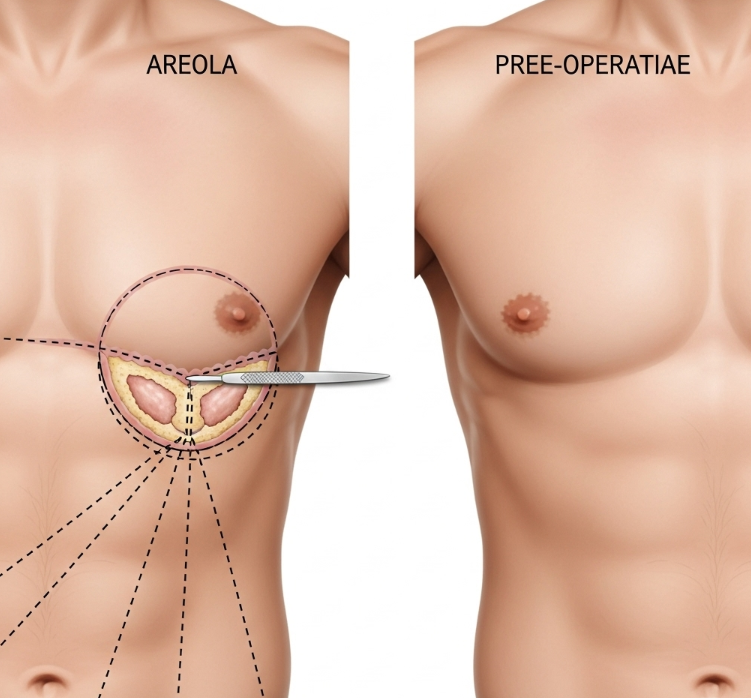Treatment Overview
Areola Incision Gynecomastia Surgery in Korea is a surgical procedure designed to treat true gynecomastia — a condition in which men develop enlarged breast tissue due to excess glandular tissue and fat. Unlike chest liposuction, which only removes fat, this method involves making a small incision along the border of the areola to remove glandular breast tissue directly.
Korean plastic surgeons are highly experienced in male chest contouring and specialize in techniques that leave minimal, nearly invisible scars hidden around the areola. In many cases, areola incision surgery is combined with liposuction for complete chest reshaping, resulting in a firmer, flatter, and more masculine chest profile.
Purpose & Benefits
- Direct Gland Removal: Treats glandular gynecomastia that liposuction alone cannot fix.
- Masculine Chest Contour: Achieves a flat, firm chest with natural definition.
- Hidden Scar Technique: Incision placed along areola border for minimal visibility.
- Combination Option: Can be combined with liposuction for fat removal and shaping.
- Boosted Confidence: Reduces self-consciousness in fitted clothing or while shirtless.
- Permanent Solution: Once glandular tissue is removed, gynecomastia does not recur.
Ideal Candidates
- Men with true gynecomastia (glandular tissue, not just fat).
- Patients whose chest remains enlarged despite weight loss.
- Adults in good health with realistic expectations.
- Men with firm, elastic skin that can adapt to a flatter chest.
- Non-smokers seeking permanent correction of gynecomastia.
Possible Risks & Complications
- Temporary swelling, bruising, and chest tenderness.
- Mild numbness or sensitivity changes around the nipples.
- Small scars around the areola (usually fade well).
- Rare risks of hematoma (blood pooling), seroma, or infection.
- Minor asymmetry in nipple or chest contour (correctable if needed).
- Rare cases of nipple inversion or flattening.
Surgical Techniques Used
- Areola Incision Technique: Small semi-circular incision made at the edge of the areola.
- Glandular Tissue Removal: Direct excision of excess breast gland tissue.
- Liposuction Combination: Often performed to remove surrounding fat for a smooth contour.
- Skin Tightening: If needed, advanced techniques or laser-assisted liposuction improve skin firmness.
- Customized Sculpting: Tailored to each patient’s chest shape and symmetry.
Recovery & Aftercare
- 1–2 weeks: Bruising and swelling peak, then improve gradually.
- Compression garment worn for 3–4 weeks to support healing and reduce swelling.
- 3–5 days: Resume light daily activity.
- 4–6 weeks: Return to gym workouts and heavy exercise.
- 2–3 months: Final results visible as chest swelling subsides.
Results & Longevity
- Flat, masculine chest profile.
- Permanent correction of gynecomastia (gland does not regrow).
- Improved self-confidence in fitted shirts or while shirtless.
- Minimal scarring due to hidden areola incision.
- Long-lasting results when paired with healthy lifestyle.
Treatment Process in Korea
1. Initial Consultation & Assessment
- Physical examination and possibly ultrasound to confirm gynecomastia (fat vs. gland).
- Discussion of whether surgery will include areola incision alone or combined with liposuction.
2. Surgical Planning & Preparation
- Incision placement carefully marked around the areola border.
- Choice of anesthesia: usually local with sedation or general anesthesia.
3. Surgery Day
- Small incision made along the areola edge.
- Glandular tissue excised directly.
- Liposuction performed if excess fat is present.
- Sutures applied for minimal scarring.
4. Post-Operative Monitoring
- Compression garment applied to minimize swelling.
- Monitoring in clinic for a few hours, then same-day discharge in most cases.
- Detailed instructions provided for chest care and activity limits.
5. Follow-Up & Refinement
- Follow-up visits at 1 week, 1 month, and 3 months.
- Secondary adjustments offered if needed for contour refinement.
Why Korea is a Top Destination
- Surgeons with extensive experience in male chest surgery and gynecomastia correction.
- Use of advanced hidden scar techniques for natural, scar-minimized results.
- Internationally recognized clinics with high safety standards.
- Emphasis on masculine definition and natural aesthetics.
- Affordable pricing compared to Western countries, with world-class care.
Cost Range
The cost of Areola Incision Gynecomastia Surgery in Korea varies depending on the severity of gynecomastia, whether liposuction is included, and the clinic’s reputation.
- Mild Gynecomastia (Gland Removal Only): USD $3,000 – $4,500
- Moderate Gynecomastia (Areola Incision + Liposuction): USD $4,500 – $6,500
- Severe Gynecomastia (Gland Removal + Extensive Liposuction + Skin Tightening): USD $6,500 – $9,000
- Premium Clinics with 3D Imaging & VIP Packages: USD $7,000 – $10,000
Additional Costs:
- Consultation & imaging: USD $100 – $300
- Compression garment: USD $50 – $150
- Medications & aftercare: USD $100 – $200
Popular Clinics
- Banobagi Plastic Surgery (Seoul): Experts in hidden-scar gynecomastia correction.
- ID Hospital (Seoul): Offers combined gland removal and liposuction for natural results.
- JK Plastic Surgery Center (Seoul): JCI-accredited, specializing in male chest surgeries.
- View Plastic Surgery Clinic (Seoul): Known for minimally invasive, natural chest contouring.
- JW Plastic Surgery (Seoul): Experienced in treating all grades of gynecomastia.




